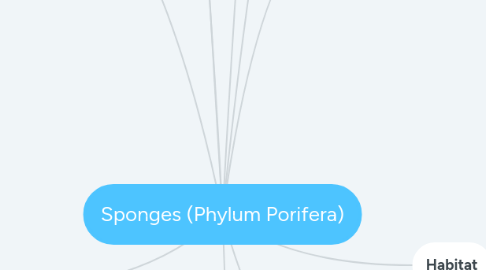
1. Leuconoid
1.1. largest and most complex body plan
1.2. more efficient water circulation
1.3. Choanocytes occupy walls of distinct chambers
1.4. Most sponges are of this type
1.5. Most species in Calcispongiae and most common type in all other classes
2. Synconoid
2.1. Medium sized body plan
2.2. Choanocytes lie in canals
2.3. Similar to asconoids
2.4. Thinker and more complex spongocoel than asconoids
2.5. Smaller diameter of canals than asconoids (more water is accessible to choanocytes)
2.6. Ingestion
2.6.1. Filters water through tiny openings (prosopyles) into radial canals (where the food is ingested by choanocyytes)
2.6.2. The choanocytes forces used water through internal pores (apopyles) into the spongocoel
2.6.3. Spongocoel is lined with epithelial-type cells not flagellated cells like in asconoids
2.6.4. After entering the spongocoel the water exits the body through an osculum
2.7. Occurs in Calcispongiae and Hexactinellida
3. Asexual Reproduction
3.1. Fragmentation (external budding)
3.1.1. somatic embryogenesis
3.2. Gemmules (internal budding)
3.2.1. survive and remain dormant
3.2.2. Escape through special openings (micropyles)
3.3. Monoecious- Having both male and female sex cells
3.4. Sperm sometimes arises from transformation of choanocytes
3.5. Most are viviparous
4. Classes
4.1. Calcispongiae
4.1.1. One, three, or four rays
4.1.2. Spicules of crystalline calcium carbonate
4.1.3. Have all canal systems( asconoid, syconoid, leuconoid)
4.1.4. Ex. Luecosolenia
4.1.5. Only class with ascon bottom
4.2. Hexactinellida
4.2.1. Glass sponge
4.2.2. Spicules with 6 rays
4.2.3. rays are arranged in right angles
4.2.4. Axial filaments
4.2.5. trabecular reticulum
4.2.6. Ex. Euplectella
4.2.7. Can have a sycon or leucon base
4.3. Demospongiae
4.3.1. spicules that develop around axial filaments or spongin fibers or both
4.3.2. Spicules not with 6 rays
4.3.3. All have leucon base
4.4. Homoscleromorpha
4.4.1. Lack a skeleton
4.4.2. Have siliceous spicules w/o an axial filament
5. Fibrous and or rigid
5.1. Collagen has many types
5.1.1. Masses surrounding spicules
5.1.2. Fibers
5.1.3. Spongin (forms skeletal network)
6. Asconoid
6.1. Smallest and simplest body plan
6.2. Choanocytes located on the internal cavity called the spongocoel.
6.3. Water exits through single large osculum
6.4. Only can collect food from water directly adjacent to the spongocoel wall
6.5. Small and tube-shaped for efficiency
6.6. Only occur in class Calcispongiae
7. "Collar Cell" Choanocytes
7.1. Beating of tiny flagella draws water past cells
7.2. Brings in food and oxygen
7.3. Carries away wastes
7.4. phagocytosis
7.5. Create water currents
7.6. ovoid cells
7.7. one end embedded in mesohyl and other end exposed.
7.7.1. Exposed end has a flagellum surrounded by a collar
7.8. Role in sexual repoduction
8. Habitat
8.1. Mostly Marine
8.2. Some "Brackish" water
8.3. Some freshwater
9. Framework
9.1. The fibrous part comes from collagen protein fibrils in the intercellular matrix of all sponges
9.2. Sponge Cells
9.2.1. Arranged in gelatinous extracellular matrix (mesohyl) or (mesenchyme)
9.2.2. No organs present
9.2.3. Archaeocytes
9.2.3.1. Phagocytize particles at the pinacoderm
9.2.3.2. Digest particles received from choanocytes
9.2.3.3. Differentiate into specialized cells
9.2.3.3.1. Sclerocytes
9.2.3.3.2. collencytes
9.2.3.3.3. spongocytes
9.2.3.3.4. lophocytes
9.2.3.3.5. pinacocytes
10. Food Entry
10.1. Tiny incurrent pores in outer layer of cells called "pinacoderm"
10.1.1. Incurrent pores (dermal ostia)
10.1.2. Digestion is intracellular
10.2. Food particles are collected on choanocyte collar
10.2.1. (suspension feeding)

